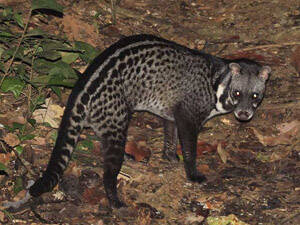
Nautiloidea is an ancient subclass of cephalopods. Today only a handful of living species remain—notably Nautilus and Allonautilus—while most nautiloids are known from the fossil record.Modern nautiluses are famous for their external, chambered shell, the shell‑traversing siphuncle andfine...

Chinese name:xùn měng lóngLatin name: VelociraptorOther names: Velociraptor ("agile thief"), Velociraptor, VelociraptorExisting period: Late Cretaceous period 83 million to 70 million years agoDistribution area: Inner Mongolia, China, MongoliaDiet: CarnivoreAggression: Very highLength:...

The giant shore crab is also commonly known as the emperor crab, and should not be confused with the king crab.The giant shore crab is a predator of many organisms, especially bivalves, polychaetes, and small crustaceans. They are mainly nocturnal, but they are active during the day depending on the...

The scientific name of the white jade snail is Achatina fulica, also known as the brown cloud agate snail, which is a subspecies of the African giant snail.White Jade Snail lives on field crops, forest trees and humid environments. It is sensitive to light stimulation. Its visibility in weak light i...

The African civet (scientific name: Civettictis civetta) is a civet in tropical Africa.The African civet is the largest representative of the African civet family. It is the only member of its genus. African civets are found in sub-Saharan Africa and most of Botswana, Namibia and South Africa. They...

Paguma larvata (scientific name: Masked Palm Civet) is a carnivorous animal of the family Viverridae and the genus Paguma. It has 16 subspecies and is commonly known as the palm civet.Paguma larvata lives in a family, often male and female, old and young, living in the same cave. They often move in...

The Spotted Fanaloka (scientific name: Fossa fossana) is also called the Spotted Fanaloka, but it is not a cat. It is called the Spotted Fanaloka because some of its characteristics are similar to those of cats after it evolved to adapt to the jungle living environment. In the past, it was classifie...

The mongoose (scientific name: Cryptoprocta ferox) is called Fossa in foreign language, and has no subspecies.The nests of the mongoose are hidden, and they are mainly active at night or at dusk, although they are occasionally observed during the day. They are solitary by nature, and usually act alo...

The scientific name of the jaguar is Panthera onca (Linnaeus, 1758), and its foreign name is Jaguar, also known as the jaguar. It is the third largest cat species in existence.Jaguars live in water-rich areas and, like tigers, are cats that love to swim. Jaguars love to travel alone, are dormant pre...

Tigon (English name Tigon) is a hybrid of a male tiger and a female lion. It is congenitally weak and more precious than a liger.The successful conception rate between lions and tigers is only 1%~2%! However, the survival rate of ligers is higher than that of tigons. The survival rate of ligers is 1...

Liger (scientific name: Panthera leo×tigris), also known as liger in English, is the offspring of a lion and a tiger. It is huge in size. Like lions and tigers, it is a member of the genus Panthera in the family Felidae. It looks similar to a lion, but has tiger stripes on its body.The world's...

The golden tiger is a golden variant of the Bengal tiger. It is golden with black stripes. It is extinct in the wild and is even rarer than the snow tiger. It is a rare animal in the world.In some legends, stories and blessings, there are often sayings such as "Golden Tiger Happy New Year"...

Pure white tigers, as the name suggests, are all white without any stripes. There have only been two pure white Bengal tigers in the world, and wild pure white tigers are now extinct.Pure white tigers live alone and are nocturnal. They mainly feed on ungulates. There is no fixed breeding season. The...

The snow tiger is the result of further mutation of the white tiger gene, with a probability of one in 100,000. It is a silver-white variant of the Bengal tiger, a rare animal in the world. There are only dozens of them in zoos around the world.The snow tiger's fur is whiter than the white tiger...

The albino Bengal tiger (English name: Bengal White Tiger) is also known as the Bengal white tiger, or "white tiger" for short. It is a variant of the Bengal tiger. Due to a genetic mutation, the Bengal tiger's original orange-yellow hair with black stripes has turned into a white-base...

The Caspian tiger (Latin name: Panthera tigris virgata) is the third largest subspecies of tiger, second only to the Siberian tiger and the Bengal tiger. It became extinct in China in 1916, and then successively became extinct in West Asia and Central Asia, and became extinct in the 1980s.The Caspia...

Bengal tiger (Panthera tigris tigris), also known as Bengal Tiger, is a nominative subspecies of tiger, also known as Indian tiger, and is the most numerous and widely distributed tiger subspecies in the world.The habitat of Bengal tigers is relatively wide. The territory of a tiger ranges from doze...

The Sumatran tiger (scientific name: Panthera tigris ssp. sumatrae), also known as the Sumatran Tiger in English, is the smallest subspecies of the same species of tiger.The main food of the Sumatran tiger is sambar deer, wild boar, porcupine, crocodile, baby rhinoceros and baby elephant. Unlike che...

The Javan tiger (Panthera tigris sondaica) is a species of tiger that once lived on the island of Java in Indonesia. It has been extinct since the 1980s. Although there are still reports of sightings, none of them have been confirmed. The Javan tiger is the third subspecies of tiger living in Indone...